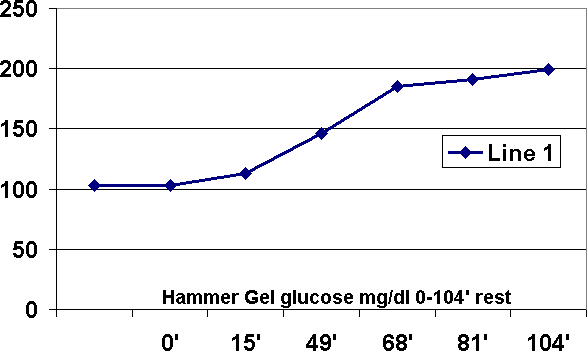Physician endurance athlete, Dr. Marty Reynolds M.D., recently shared an interesting “case study” for appropriately answering this question:
My wife is a Type I diabetic (on an insulin pump) that is running her first half-marathon in Austin in February. We tested ALL gel products, and found Hammer Gel to be the most reliable and consistent in providing carbohydrate to keep her blood glucose level normal during a run (we tested almost every alternative product we could obtain, such as____,______,____, <snip>).
A friend of ours that also has diabetes (on an insulin pump too), who has successfully completed four Ironman Triathlons, has told us that she has found your gel products to be the best for her glucose control. If you ever receive any queries from athletes with diabetes that would like to talk to someone about Hammer Gel for glucose control, I’d be happy to respond to their e-mail. This data was obtained by measuring blood glucose after taking Hammer Gel when my wife Paula, diabetic athlete, was NOT exercising.
She and I have even gone to the extreme of taking a unit dose of the gel, then measuring blood glucose levels (which will rise in a diabetic in direct correlation to carbohydrate absorption, when insulin is not given to cover) every 15 minutes for two hours to plot out phamacodynamic curve of Hammer Gel. This interesting data shows that the Hammer Gel begins absorption approximately 30-45 minutes after ingestion, then supplies carbohydrates at a steady state for the next approximately 45 minutes, and then tapers off.
Knowing this alters how I take the gel (i.e. I take the first gel at the start of the run, and I won’t take any during the last hour of a run as it makes no sense to do so, unless you are relying on it for glycogen repletion after exercise has terminated…
Here is how Hammer Gel affected my wife’s blood glucose levels taken during rest:
HAMMER GEL EFFECTS DIABETIC I GLUCOSE LEVELS AT REST
| Time (minutes) | Glucose mg/dl |
| 0 | 103 |
| 15 | 113 |
| 49 | 146 |
| 68 | 185 |
| 81 | 191 |
| 104 | 199 |
Note: at time 0 a Type I diabetic with a stable blood glucose level ingested one serving of Hammer Gel and no additional insulin was given to cover this carbohydrate intake, blood glucose levels were then measured periodically over the next two hours.

1. Hammer Gel glucose mg/dl 0-104′ curve diabetic I female (at rest)
The above figures were taken during rest (not during exercise when blood sugar turnover rate is higher), which is why the recorded rise in blood glucose was modestly above the ideal glucose values. If my wife had been exercising during that time, her blood glucose would have been normal and stable. In fact, she recently completed a two-hour run using Hammer Gel with her blood glucose at the end of exercise being a healthy normal 112 mg/dl. This shows that Hammer Gel is virtually perfect for keeping blood glucose levels NORMAL and STABLE. The dose amount and timing should be worked out for each individual. For her, at 57 kg body weight, when performing at a moderate intensity rate (heart rate ~ 70-75% of maximum), a single packet of Hammer Gel works out just perfect. Athletes with diabetes with different body weights or doing exercise with different intensity levels may need to adjust the dose amount.
Therefore, I adopted the following guidelines for taking Hammer Gel during exercise:
“Take one dose of Hammer Gel approximately 30 minutes prior to beginning exercise. This one dose alone will cover an exercise session of 45 minutes or less. If the exercise session is planned to continue beyond 45 minutes, then another dose of Hammer Gel is taken at the beginning of exercise. The dose is subsequently repeated every 45 minutes (frequency can be decreased to once an hour during prolonged exercise of > 2 hours). No additional doses of Hammer Gel should be taken when the exercise session is expected to end in less than 75 minutes. When following this protocol, blood glucose values are normal at the start of exercise (between 120-140 mg/dl) and remain stable throughout the exercise sessions (+/- 15% of the starting value), and continue normal through to the end of exercise (usually between 120-140 mg/dl). This is ideal for diabetic blood sugar control and athletic performance.
If any type I diabetic patients that need more information, an excellent source is the book, Pumping Insulin, by John Walsh & Ruth Roberts. Chapter 18 and 19 discuss the gram amount of carbohydrate intake required based upon athlete weight, exercise intensity, and exercise duration.
The only thing missing from their discussion is what commercially available carbohydrate formulations provide a steady state glucose absorption over time, and what timing should be used for their intake so that a diabetic athlete’s blood glucose level can be maintained in a steady state.
This is the final piece of information that Paula and I had to derive by word of mouth from other diabetic athletes, as well as trial and error, and our mini-experiment. However, doing this has allowed her to successfully complete a half-marathon and begin training for a full marathon using your company’s product.”
Sincerely,
Marty Reynolds, M.D.
marty@firstssw.com
COMMENT:
This remarkable “case study” reports how a diabetic athlete controlled blood sugar using Hammer Gel during exercise.
This does not conclude that everyone with a blood sugar disorder will enjoy the same results using the same frequency and dose.
However, these guidelines help diabetics to determine how much Hammer Gel to take and how often for generating a healthy blood glucose response during exercise. I wish to thank Dr. Reynolds and his wife, Paula, for sharing this report.

